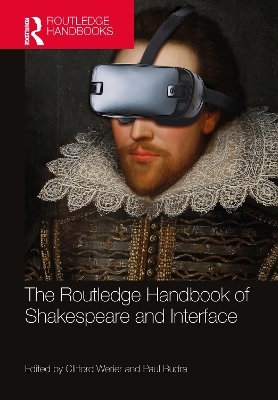
The Routledge Handbook of Shakespeare and Interface
Routledge (Verlag)
978-0-367-42088-8 (ISBN)
The Routledge Handbook of Shakespeare and Interface provides a ground-breaking investigation into media-specific spaces where Shakespeare is experienced. While such operations may be largely invisible to the average reader or viewer, the interface properties of books, screens, and stages profoundly mediate our cognitive engagement with Shakespeare.
This volume considers contemporary debates and questions including how mobile devices mediate the experience of Shakespeare; the impact of rapidly evolving virtual reality technologies and the interface architectures which condition Shakespearean plays; and how design elements of hypertext, menus, and screen navigation operate within internet Shakespeare spaces. Charting new frontiers, this diverse collection delivers fresh insight into human–computer interaction and user-experience theory, cognitive ecology, and critical approaches such as historical phenomenology. This volume also highlights the application of media and interface design theory to questions related to the medium of the play and its crucial interface with the body and mind.
Clifford Werier is Professor of English at Mount Royal University, Canada. His recent publications investigate time across media in Shakespearean jokes and the application of meme theory to the spread of contagious ideas in Coriolanus. He is the co-editor of Shakespeare and Consciousness (2016) and is the interface team leader on the Linked Early Modern Drama Online project. Paul Budra is Professor of English at Simon Fraser University, Canada. He has published six books and numerous articles on early modern drama and contemporary popular culture. He is the director of SFU Publications and a past president of the Pacific Northwest Renaissance Society.
Introduction
Clifford Werier and Paul Budra
Part 1
Media and the embodied mind
1 Reading Shakespeare: Interface and Cognitive Load
Clifford Werier
2 Shakespeare and Virtual Reality
Rebecca Bushnell and Michael Ullyot
3 All the Game Is a Stage: The Controller and Interface in Shakespearean Videogames Mark Kaethler
4 Voice as Interface
Bruce Smith
Part 2
Apparent designs and hidden grounds
5 Shakespearean Interfaces and Worldmaking: Buried Narratives, Hidden Grounds, and the Culture of Adaptive Practice
Daniel Fischlin
6 What Are Interfaces For, Really?
Gabriel Egan
7 Interface Design and Editorial Theory
Gary Taylor
8 Abstraction as Shakespearean Interface
Jonathan Lamb and Suzanne Tanner
Part 3
Surfaces and depths
9 The Hamlet First Quarto (1603) and the Play of Typography
Erika Boeckeler
10 Desiring Bodies, Divine Violence and Typographic Interfaces in Champ Fleury and Venus and Adonis
Simon Ryle
11 "If you can command these elements": TEI Markup as Shakespearean Interface
Sarah Connell
Part 4
Display, navigation, and functionality
12 "Into a thousand parts divide": The Pursuit of Precision in Shakespeare’s Interfaces
Rebecca Niles
13 Does Jonson Break the Data Model? Interrelated Data Models for Early Modern English Drama
Meaghan Brown
14 Browse as Interface in Shakespeare’s Texts and The World Shakespeare Bibliography Online
Heidi Craig and Laura Estill
Part 5
User experience
15 "Make Your Best Use of This": A Case Study in User Experience Design for a Shakespeare Interface
Kurt Daw
16 Using Data and Design to Bring the New Variorum Shakespeare Online
Anne Burdick, Laura Mandell, Bryan Tarpley, and Katayoun Torabi
17 Mediating the Shakespeare User’s Digital Experience
Eric Johnson and Stacey Redick
Part 6
Staging the interface
18 Access Points: Stage, Space, and/as Interface in the Early Modern Playhouses
Laurie Johnson
19 The Heuristics of Interface: Shakespeare’s Cymbeline
Lauren Shohet
20 Shakespeare Through the Bare Thrust Stage Interface
Shoichiro Kawai
Part 7
Interfacing with performance
21 Shakespeare’s Walking Story: Site-specific Theater in a Covid World
Gretchen Minton
22 Interfacing Shakespeare Onscreen
Alexa Joubin
23 Front to Front: Enactment as Interface
Mary Hartman
24 Zoom Shakespeare
Paul Budra
| Erscheinungsdatum | 17.08.2022 |
|---|---|
| Reihe/Serie | Routledge Literature Handbooks |
| Zusatzinfo | 1 Line drawings, black and white; 41 Halftones, black and white; 42 Illustrations, black and white |
| Verlagsort | London |
| Sprache | englisch |
| Maße | 178 x 254 mm |
| Gewicht | 890 g |
| Themenwelt | Geisteswissenschaften ► Sprach- / Literaturwissenschaft ► Anglistik / Amerikanistik |
| Geisteswissenschaften ► Sprach- / Literaturwissenschaft ► Literaturgeschichte | |
| Geisteswissenschaften ► Sprach- / Literaturwissenschaft ► Literaturwissenschaft | |
| Geisteswissenschaften ► Sprach- / Literaturwissenschaft ► Sprachwissenschaft | |
| Sozialwissenschaften ► Kommunikation / Medien ► Medienwissenschaft | |
| ISBN-10 | 0-367-42088-0 / 0367420880 |
| ISBN-13 | 978-0-367-42088-8 / 9780367420888 |
| Zustand | Neuware |
| Haben Sie eine Frage zum Produkt? |
aus dem Bereich


